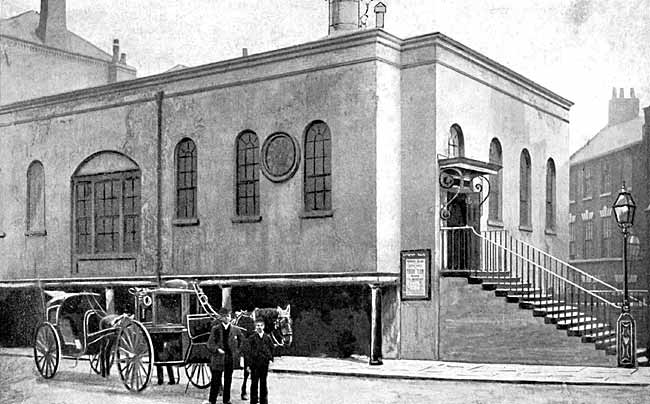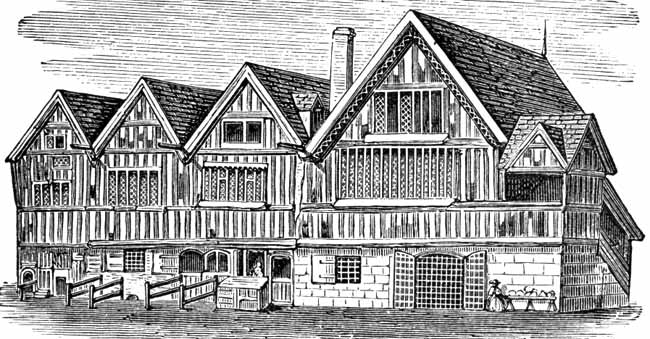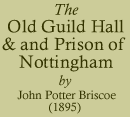The Old Guild Hall and Prison of Nottingham
I.

The Old Guild Hall, c.1890.
WHAT was for a long period an interesting and useful building has been demolished, and its site will shortly be utilised for the progress of the "iron horse' through the old town. Where the old-time prison, Guild Hall, and police court until recently stood, there will be nothing left to remind us by sight-sense of their former existence in our midst. The screech of the "puffing Billy" will be heard from where the moans of miserable prisoners formerly reached the ears. The old order has given way to the new. The requirements of our late nineteenth century have necessitated the provision of more commodious and otherwise suitable buildings, and the old town hall has now become a thing of the past— only its history and memories remaining to us. Let us, therefore, collect what we can respecting it. All prisons formerly belonged to the Crown. One of these was early located in Nottingham, and the charter of confirmation of Edward the Third recites an inquisition taken and retained in Chancery, whereby it was stated "that the burgesses time out of mind, and until the time of King John's Charter and since, had a gaol in the town for the custody of such as were taken therein as belonging to the town."
The history of the old Guild Hall and the prisons is interesting, and ample materials exist for the preparation of a volume on the subject. There are many references in the valuable series of "Records of the Borough of Nottingham," from the commencement of the fourteenth century onwards. From this treasure-house of local history, we gather that in 1501-2 one William was the gaoler; that Isolda Arundel was imprisoned on suspicion of theft; that four years later John Chapman was imprisoned for theft and pilloried; that in 1316 Walter le Shepherd was imprisoned and sentenced to be hung for sheep stealing; that about the same time Gervase Aubrey, for stealing a cow, was similarly treated. In 1328, John, son of William de Hamsterley, was lodged here on the charge of purloining a chest of small value. He was ordered to leave and remain away from the town. Had the theft been of greater value he would have been suspended by the neck for life, and after. In 1330, William de Herle and Nicholas Fastolf were the judges here. Before these representatives of the majesty of the law, it was proved by the burgesses that they had a gaol "from time whereof memory did not exist at the time of the Charter of King John being made" (March 19, 1199-1200). This was only a confirmation of that of the Second Henry (1155-6) of the customs enjoyed by prescription before charters were granted.
For leaving the service of the bailiffs of Nottingham, Nicholas de Oure was imprisoned here in 1351. From the same source we gather that, to disclaim his responsibility as a husband, John de Westhorp proclaimed in full court that he would not be responsible for any debts contracted by his spouse. This was in 1386. Eight years later, in 1394, John de Belby was incarcerated here for contempt of court.
Near the close of the next century it became necessary to enlarge the prison. In 1479, John Pole, of Nottingham, gave thirty-five feet of land near the "Guild Hall Gate." This gift was confirmed by the Archbishop of York, who cleared the land from ecclesiastical claims. This land was the site on which the prison was enlarged. The Guild Hall about this period answered many requirements—legal, commercial, and otherwise. It occupied the first floor, and the basement was utilised as an armoury, as a barber's shop, and as two drink shops. A room over the old hall was, in the seventeenth century, utilised as a depot for the "trained bands" of the county. In 1642, the Earl of Newcastle and Sir John Digby endeavoured to seize the stores for the use of the king, but their designs were frustrated by Mr. (afterwards Colonel) Hutchinson, who, as the representative of the people, urged them to abandon the idea of doing so.
During the first half of the eighteenth century this was a low wooden building which "bore the badge of antiquity," and has until very recently occupied a site on the south side of Weekday Cross, on the Middle Pavement. Deering, the historian, informs us that "the first room was spacious. Formerly it was used as the Assize Court and Sessions Hall for the town. Over the seat where the judge, and at other times the mayor, used to sit, were the king's arms handsomely painted. On each side there were hung the arms of nine of the benefactors of the town, with suitable inscriptions under them. Within this court there was a handsome wainscotted chamber, called the Council House (which anciently did not belong to the hall), where the mayor and his brethren, with the rest of the members of the Corporation, transacted the business of the town. The town records were kept here, under three locks and keys, which were held by the mayor, the youngest alderman (not being mayor), and the senior coroner. Burgesses were chosen here to represent the town in Parliament. Under the hall was a prison, for debtors above and for felons below." Deer-ing further tells us that in his day the prison was in very bad order, especially that for felons. The roof, which was probably nearly seven hundred years old, and framed not unlike the old Westminster Hall, was perfectly sound.

The Guild Hall in 1741.
Thomas Sandby made a pen-and-ink drawing of the building in 1741. This came under our notice in the early seventies, when we induced the Free Library Committee to secure it for the town. After remaining in our possession as Public Librarian for some years, it was transferred to the Castle Museum. It was reproduced in part (the upper portion), with additions, by Mr. Hine, and forms the folding plate to that gentleman's work on Nottingham; and in facsimile in the Borough Records, having been previously used to illustrate Throsby's Thoroton. Our woodcut illustration is "after T. Sandby." It will be seen that the building was a four gabled one. The Assizes and Sessions were held in that portion with the largest gable—the west end. This hall was approached by a flight of covered steps which ran by the side of the building, and not in a line with the front, as was the case with the now-demolished building. The second gabled portion was designated "the Council House." This may have extended to the third part of the building. The gaol for debtors was under the next, or furthest, portion of the building, and the "ancient gaol for felons" under the Assize Hall, on the ground floor. The tanners warehoused their leather beneath the gaol for debtors— the east end of the building.
At one of the openings is portrayed a turner in wood. He is using the old "pole " or "dead-cutter" lathe, which was the general form of lathe in use in the last century.
At this time, 1741, the prison was in a bad condition, especially the felons' portion. The roof timbers of the great hall were, however, perfectly sound, although they were reputed to have been seven hundred years' old at that time. The felons' prison and the Assize Hall were repaired about 1744, and the old timbers in the last-mentioned portion were suffered to remain. The lower portion of the front was of stone, and the upper was half timbered
